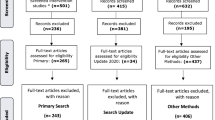Abstract
Discussion of theoretical rationale, form and content of therapy groups for pre-adolescent boys emphasizing practice in interpersonal competence in addition to teaching social skills. Members' individual developmental stage, group development, and the construction of social order by children inform the structuring of group and the evaluation of members' progress. Roles and responsibilities of group members, parents or guardians, and therapist(s) as the treatment team are described as essential components for efficacy.
Similar content being viewed by others
REFERENCES
Bar-On, R. (1997). The Emotional Quotient Inventory (EQ-i): Technical Manual. Toronto: Multi-Health Systems.
Beck, A. P. (1974). Phases in the development of structure in therapy and encounter groups. In Wexler, D. A. & Rice, L. N. (Eds.), Innovations in client-centered therapy. New York: Wiley.
Brabender, V.M. (1985). Time-limited inpatient group therapy: A developmental model. International Journal of Group Psychotherapy 35, 373–390.
Braucher, D. (1998). Darth Vader vs. Superman: Aggression and intimacy in two preadolescent boys' groups. JCAGT 8(3), 115–134.
Dies, K. R. (1991). A model for adolescent group psychotherapy. Journal of Child and Adolescent Group Therapy JCAGT 1(1), 59–70.
Garland, J. A. (1992). The establishment of individual and collective competency in children's groups as a prelude to entry into intimacy, disclosure, and bonding. International Journal of Group Psychotherapy 12(3), 395–405.
Gardner, H. (1983). Frames of mind: The theory of multiple intelligences. New York: Basic Books.
Gardner, H. (1993). Multiple Intelligences: The theory in practice. New York: Basic Books.
Goleman, D. (1995). Emotional Intelligence. New York: Bantam Books.
Goleman, D. (1998a). What makes a leader? Harvard Business Review, 76, 93–102.
Goleman, D. (1998b). Working with Emotional Intelligence. New York: Bantam Books.
Hoag, M. J., & Burlingame, G. M. (1997). Child and adolescent group psychotherapy: A narrative review of effectiveness and the case for meta-analysis. JCAGT7(2), 51–68.
Kihlstorm, J. F. & Cantor, N. (2000). Social intelligence. In Sternberg, R. J. (Ed.), Handbook of Intelligence. New York: Cambridge University Press.
MacKenzie, K. R. & Livesley, W. J. (1983). A developmental model for brief group therapy. In Dies, R. R. & MacKenzie, K. R. (Eds.), Advances in group psychotherapy: Integrating research and practice. New York: International Universities Press.
Marriage, K. J., Gordon, V., & Brand, L. (1995). A social skills group for boys with Asperger's Syndrome. Austrailian and New Zealand Journal of Psychiatry 29, 58–62.
Mayer, J. D., Salovey, P., & Caruso, D. (2000). Models of emotional intelligence. In Sternberg, R. J. (Ed.), Handbook of Intelligence. New York: Cambridge University Press.
Mishna, F. & Muskat, B. (1998). Group therapy for boys with features of Asperger's Syndrome and concurrent learning disabilities: Finding a peer group. JCAGT 8(3), 97–114.
Soo, E. S. (1992). The Management of resistance in the application of object relations concepts in children's and adolescents' group psychotherapy. JCAGT 2(2), 77–92.
Sternberg, R. J., Conway, B. E., Ketron, J. L., & Bernstein, M. (1981). People's conceptions of intelligence. Journal of Personality and Social Psychology 41, 37–55.
Tuckman, B. W. (1965). Developmental sequence in small groups. Psychology Bulletin 63, 384–399.
Yalom, I. D. (1975). The theory and practice of group psychotherapy (2nd ed.). New York: Basic Books.
Author information
Authors and Affiliations
Rights and permissions
About this article
Cite this article
Hedges-Goettl, L., Tannenbaum, M. Navigating the Social Landscape: A Rationale and Method for Interpersonal Group Therapy with Pre-adolescent Boys. Journal of Child and Adolescent Group Therapy 11, 135–146 (2001). https://doi.org/10.1023/A:1014710523358
Issue Date:
DOI: https://doi.org/10.1023/A:1014710523358




